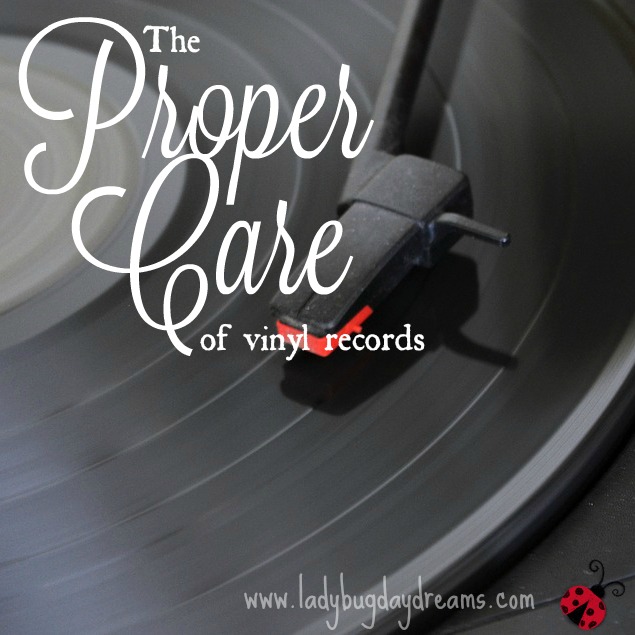After reading my post on why we switched to vinyl records, Will thought it might be good to do a followup on the proper way to care for them. So here we are.
Disclaimer: We’re pretty new to vinyl records ourselves, so this list probably isn’t comprehensive. It’s just things we’ve learned and observed in our weeks of record playing.
There aren’t that many rules in regards to vinyl records, but there are a couple. And the better care you take of your vinyl records, the longer they’ll last and therefore, the longer you’ll enjoy them.
Stack your records vertically, not in a pile.
If you pile your records up, they’re likely to warp from the weight of themselves. You should treat records like a hardback book. We keep ours on a small shelf with hardback books, in fact. Then we lean one of the books (not a record) to keep the vinyls upright.
Clean all albums regularly. When buying used, clean them before playing.
You’ll need to buy a specialty cleaning kit to do this. It costs about $20 and comes with a record cleaning brush, cleaning solution, and a small brush with which to clean your brush.
Records attract static electricity, which in turn attracts dust. This means that you’ll need to clean your records periodically. Information on how often varies from site to site; some say to clean them with each play, and others say to clean them only when they look dusty. And there are a myriad of other options in between. Since there’s no right or wrong answer here (apparently), use your best judgement.
Make sure your kids understand the cost of a record.
This might seem like an obvious one, but it’s as important as any of the others on this list. Records are tough, but they’re not indestructible. They can be broken, bent, warped, and otherwise destroyed. Teach your children the proper care of them and pass along the love of records! We’ve done this by allowing each of our children to purchase a record (we paid for it, up to $10, then they paid anything over if they wanted something more expensive) that was theirs. They’re taught how to play the record and how to put it away. They’re taught how to clean it. Basically, they are in charge of their own record. Having one that belongs to them personally gives them some sense of ownership, and therefore they care more about it.
Have good dust sleeves. Paper is better than plastic.
Moving the records in and out of plastic sleeves will attract even more static than the records do anyway, so paper sleeves are better. All new records will come with dust sleeves, and most used ones will as well. With used records, though, the sleeves may not be in very good condition, so you might have to buy new ones. Our record store sells them for $5.95 for a 24-pack.
They can get cold, but too hot and they melt.
Records are basically made from plastic, so this is a no-brainer. Don’t leave them in direct sunlight or put them in your oven ;). In all seriousness, though, over about 90 degrees F and you’ll have problems. So if your house gets really hot in the summertime, you’ll need to find a safe place to store your records during those months.
Avoid thrift stores.
This doesn’t mean don’t buy used records. It means buy them from official record stores when you do. And I heartily recommend buying used records. You’re likely to find some real gems in the used section of the record store that you’d never ever be able to get new. It’s definitely worth buying used, but you want to buy them from someone who knows about records rather than someplace where people just dump their excess, broken, warped records and employees don’t know the difference between a good one and one that no longer plays. Most of these types of stores (the good ones, not the bad ones) have a quality scale for their used records. Pay attention to that scale, and only buy records from the top two tiers of quality. Definitely never buy the “as is” records – even from a record store, that’s no better than a regular thrift store.
When handling records, treat them like a photograph.
When you look at a record up close, you’ll notice that there’s a rim along the outside edge that’s thicker – almost like a pizza crust. There are no grooves here, and therefore no music. This is where you want to hold your records when moving them from their cases to the player and back again.
Vinyl records are a lot of fun. By following these simple guidelines, you’ll prolong the life of your records, assuring that you can enjoy to them for years to come.
Happy Listening!



Good tips. Now that vinyl has become popular with a younger generation, you have a lot of vinyl owners who have no idea how to properly handle their records. I can’t tell you how many times I’ve winced involuntarily watching people browse in a record store!
David Richard recently posted…Record Player Stands – Reviewing and Comparing the Top 10
My husband is the same way. In fact, he’s begun training the “older generation” (our parents), who grew up with vinyl, to care for their collections properly because apparently that wasn’t something that was done in the 70s.